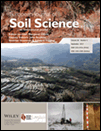Ver ítem
- xmlui.general.dspace_homeCentros e Institutos de InvestigaciónCIRN. Centro de Investigaciones de Recursos NaturalesInstituto de SuelosArtículos científicosxmlui.ArtifactBrowser.ItemViewer.trail
- Inicio
- Centros e Institutos de Investigación
- CIRN. Centro de Investigaciones de Recursos Naturales
- Instituto de Suelos
- Artículos científicos
- Ver ítem
Hierarchy of factors driving N2O emissions in non‐tilled soils under different crops
Resumen
Nitrous oxide (N2O) is emitted to the atmosphere as a by‐product of nitrification and denitrification by soil microbial processes. Differences in climate, soil and management regulate these processes, causing N2O emissions to vary in space and time. This study aimed to identify and rank the soil properties that control N2O emissions in non‐tilled soils under different crops. Over a period of 2 years, gas samples were taken from closed chambers and soil
[ver mas...]
Nitrous oxide (N2O) is emitted to the atmosphere as a by‐product of nitrification and denitrification by soil microbial processes. Differences in climate, soil and management regulate these processes, causing N2O emissions to vary in space and time. This study aimed to identify and rank the soil properties that control N2O emissions in non‐tilled soils under different crops. Over a period of 2 years, gas samples were taken from closed chambers and soil properties were determined once per season. N2O emission rates were highly variable (from −15 to 314 µg N2O‐N m−2 hour−1). A regression tree analysis allowed us to classify soil N2O emissions into three groups, separated by topsoil temperature (primary factor) and water‐filled pore space (WFPS, secondary factor). N2O emissions were small (mean 4.22 µg N2O‐N m−2 hour−1) with topsoil temperature less than 14°C (Group 1), large (mean 61.87 µg N2O‐N m−2 hour−1) with topsoil temperature between 14 and 23°C and WFPS more than 58.5% (Group 2) and moderate (mean 21.4 µg N2O‐N m−2 hour−1) with topsoil temperature more than 23°C and WFPS less than 58.5% (Group 3). These emission groups allow for more efficient sampling of N2O emissions in the field: in winter, when topsoil temperatures are less than 14°C and N2O emissions are expected to be small or even negligible, sampling frequency can be reduced; in autumn and spring, when topsoil temperatures are more than 14°C and WFPS is more than 60–70%, sampling frequency should be increased.
[Cerrar]

Autor
Cosentino, Vanina Rosa Noemi;
Figueiro Aureggi, Santiago Andres;
Taboada, Miguel Angel;
Fuente
European Journal Of Soil Science 64 (5) : 550-557 (October 2013)
Fecha
2013-10
Editorial
Wiley
ISSN
1351-0754
1365-2389
1365-2389
Formato
pdf
Tipo de documento
artículo
Palabras Claves
Derechos de acceso
Restringido
 Excepto donde se diga explicitamente, este item se publica bajo la siguiente descripción: Creative Commons Attribution-NonCommercial-ShareAlike 2.5 Unported (CC BY-NC-SA 2.5)
Excepto donde se diga explicitamente, este item se publica bajo la siguiente descripción: Creative Commons Attribution-NonCommercial-ShareAlike 2.5 Unported (CC BY-NC-SA 2.5)

